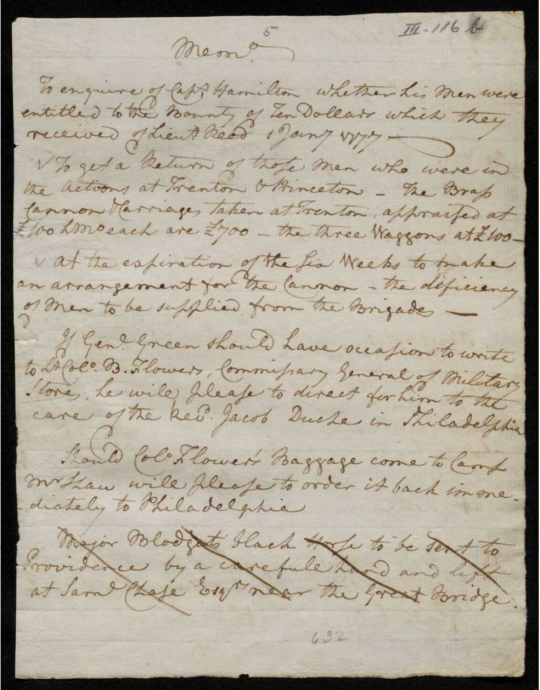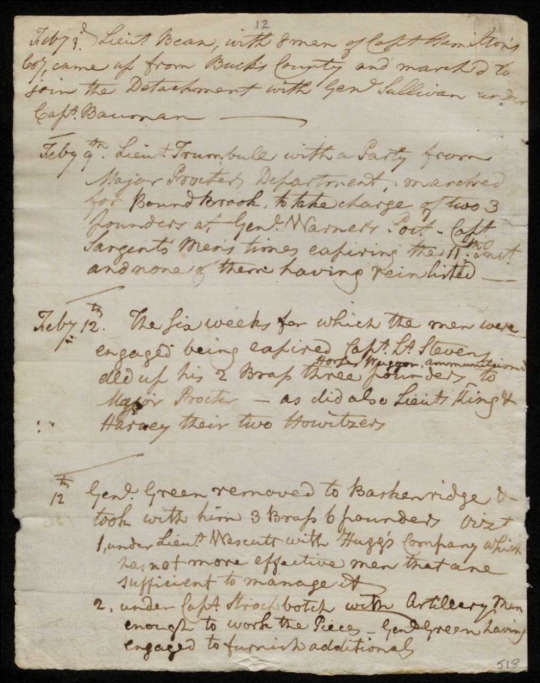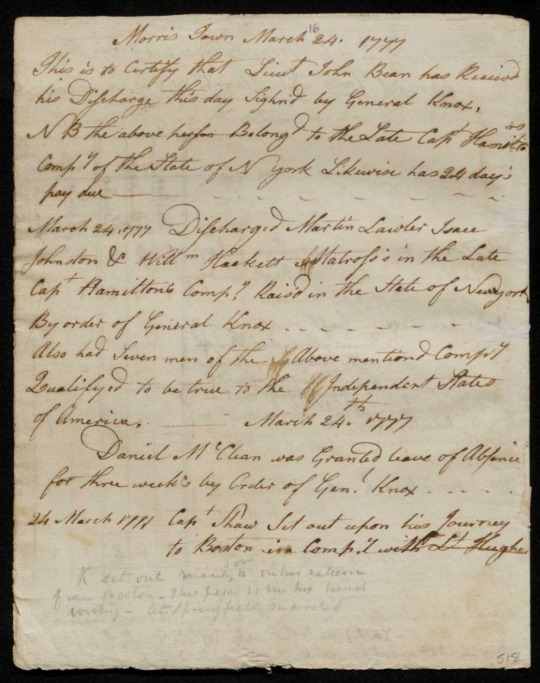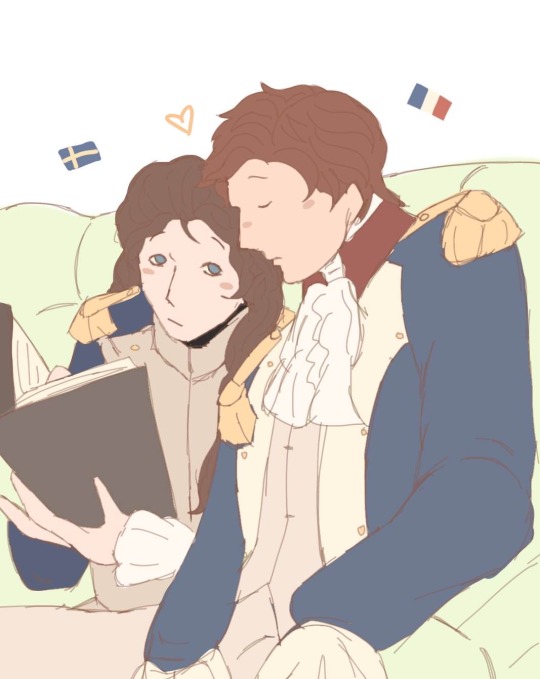#Henry knox
Explore tagged Tumblr posts
Text
New Findings For Alexander Hamilton’s Artillery Company!!
Today I came across “new” (new to me, anyway--nor have I seen a Hamilton biographer or scholar mention this) Captain Hamilton information and I feel bad for the people within my vicinity inside my campus library who had to hear my shocked squeal.
Within the Henry Knox Papers of the Gilder Lehrman Collection held by the Gilder Lehrman Institute of American History is an “Artillery record book” which was written by Colonel Samuel Shaw for Knox’s regiment of artillery between January 12, 1777 and March 24, 1777. The book itself is only 16 pages (which includes the cover page), but it contains all sorts of troop movements, artillery inventory, and other notes.
The following (under the cut) is a chronological rundown of all the times Hamilton or his men are mentioned in the book, along with the images themselves (as unfortunately the database that the Knox Papers were digitized to, American History 1493-1945, is limited to institutional access. However, it can be found here):

First up, on page five (seen above), Colonel Shaw wrote a series of "memos," or tasks needing completion. One of these, as seen at the top of the page, included "To enquire of Capt Hamilton whether his men were entitled to the Bounty of Ten Dollars which they received of Lieut Reed 1 Jany [January] 1777 --". The start of the new year came of course on the heels of the Battle of Trenton fought on December 26, 1776, wherein Hamilton's cannons played a major role.

Next (and the most interesting to me), on page twelve (seen above) Shaw wrote a series of troop movements. Dated February 3, 1777, the colonel wrote that "Lieut [John] Bean, with 8 men of Capt Hamilton's Coy [Company] came [up?] from Bucks County and marched to join the Detachment with Genl [John] Sullivan and Capt [Sebastian] Bauman --". At this time, Hamilton was still in recovery from the illness he developed prior to Trenton, and the only other remaining officer in his company was his Third Lieutenant Thomas Thompson. This would thus mean that Hamilton and Thompson were left to watch over those that remained with the company while Bean and eight enlisted men were away.

Lastly, on the final page of the record book (seen above) a series of discharges for men in Hamilton's company were written on March 24, 1777. By that time, Alexander Hamilton had joined Washington's staff as an aide-de-camp. Colonel Shaw, and another person who has not been identified, explicitly wrote:
Morris Town March 24, 1777
This is to certify that Lieut John Bean has Received his Discharge this day Sign'd by General Knox, N B the above person Belong'd to the late Capt Hamilton's Compy [Company] of the State of N[ew] York Likewise has 24 days pay due --
March 24, 1777 Discharged Martian Laulen[,] Isaac Johnston & Will'm [William] Hackett Matross's in the Late Capt Hamilton's Compy, Rais'd in the State of New York By order of General Knox . . . .
Also had seven men of the above mentioned compy Qualifyed [Qualified] to be true to the Independent States of America --
Note: the names of the matrosses discharged were cross-referenced with the names found in Alexander Hamilton's artillery company pay book for making my above transcription.
This entire record makes me extremely happy. I have new dates and more minute details and therefore a more concrete timeline surrounding Hamilton and the men of his company, yay!! Lately I have become very interested in the company's continuing service in the American Revolution after Hamilton's departure, and this record just gave me some fascinating information that links to some other information I have found on the whereabouts of some of these men written about above. But this is daring to open a can of worms that should be saved for a later post.
Frankly, it does not surprise me that I have not read about this record previously. It is so detailed and routine that it doesn't stand out necessarily on its own in the wider scope of things. However, as regards The American Icarus (and another project I may or may not be considering tackling?), this new information is very interesting and helpful. And I hope someone else here finds it interesting too.
#I would update my captain hamilton timeline if not for having hit my image and hyperlink limit on that post 😭#grace's random ramble#alexander hamilton#amrev#historical alexander hamilton#captain hamilton#henry knox#amrev fandom#historical hamilton#american revoluton#historical documents#18th century letters#continental artillery#continental army#george washington#battle of trenton#american history#historical research#historical resources#henry knox papers#gilder lehrman institute of american history#the american icarus#TAI#my projects#my writing#writeblr#new york provincial company of artillery
39 notes
·
View notes
Text
I love the fact that Alexander was scared of gun shots so much that whenever he heard a soldier yell "shells" he went and hid behind Henry Knox 😭
I can imagine it just going like:
Soldier: "Shells!"
Hamilton: *uses Knox as human shield*
Knox: "boy, get your scary ass from behind me.."
112 notes
·
View notes
Text

The Battle of Princeton, January 3, 1777
Reenactment - 1/5/2025
21 notes
·
View notes
Text

꒷︶꒷꒥꒷‧₊˚૮꒰˵•ᵜ•˵꒱ა‧₊˚꒷︶꒷꒥꒷
I can't stop drawing the two 😭😭 it's like a drug to me /hj
ೋ❀❀ೋ═══ ❀ ═══ೋ❀❀ೋ
Guys please praise Ferfayette ( Lafayette x Fersen)
:3
#art#fanart#history#ship art#axel von fersen#historical#marquis de lafayette#alexander hamilton#american revolution#amrev#shipping#ferfayette#lersen#george washington#john laurens#henry knox
24 notes
·
View notes
Text

The Saturday Evening Post 1902-02-15
Cover art by George Gibbs
#The Saturday Evening Post#vintage magazine#magazine cover#magazine#vintage magazine cover#vintage#early 20th century#20th century#1900s#1902#February#Presidents' Day#Presidents Day#George Washington#Thomas Jefferson#Alexander Hamilton#Henry Knox#Edmund Randolph#government#US Government#18th century#1700s#George Gibbs#internet archive
8 notes
·
View notes
Text
Turn Week 2024: Day 6 - Cross-Over/International Kissing Day
I do not have anything to contribute to Cross-Overs … but I thought to capitalize on the 6th being International Kissing Day!
Kiss our dear Henriette twenty times for me.
The Marquis de La Fayette to his wife Adrienne, March 7, 1777.
Idzerda Stanley J. et al., editors, Lafayette in the Age of the American Revolution: Selected Letters and Papers, 1776–1790, Volume 1, December 7, 1776–March 30, 1778, Cornell University Press, 1977, p. 27.
Kiss our little Anastasie a million times. Alas, she is all that is left to us. I feel that my once divided fatherly affection is now completely for her; take great care of her.
The Marquis de La Fayette to his wife Adrienne, June 16, 1778
Idzerda Stanley J. et al., editors, Lafayette in the Age of the American Revolution: Selected Letters and Papers, 1776–1790, Volume 2, April 10, 1778–March 20, 1780, Cornell University Press, 1979, p. 79.
Ah, my dear heart, when shall I be close to you? When shall I be able to kiss you a hundred times?
The Marquis de La Fayette to his wife Adrienne, September 13, 1778
Idzerda Stanley J. et al., editors, Lafayette in the Age of the American Revolution: Selected Letters and Papers, 1776–1790, Volume 2, April 10, 1778–March 20, 1780, Cornell University Press, 1979, p. 173.
A thousand and thousand tender kisses for my dear Anastasie, and a big hug for George. Farewell, my love.
The Marquis de La Fayette to his wife Adrienne, May 6, 1780.
Idzerda Stanley J. et al., editors, Lafayette in the Age of the American Revolution: Selected Letters and Papers, 1776–1790, Volume 3, April 27, 1780–March 29, 1781, Cornell University Press, 1980, p. 10.
My Most Respectfull and Affectionate Compliments to Mrs. Knox; I am so impudent as to take the liberty to Adress a kiss to Lucy-and a paternal one to My Son. Adieu Yours forever
The Marquis de La Fayette to General Henry Knox, August 18, 1781.
Idzerda Stanley J. et al., editors, Lafayette in the Age of the American Revolution: Selected Letters and Papers, 1776–1790, Volume 4, April 1, 1781–December 23, 1781, Cornell University Press, 1981, p. 334.
My Best Respects Wait Upon Mrs. Knox, and Miss Lucy. I most affectionately and fatherly kiss my Son Harry.
The Marquis de La Fayette to General Henry Knox, January 8, 1784.
Idzerda Stanley J. et al., editors, Lafayette in the Age of the American Revolution: Selected Letters and Papers, 1776–1790, Volume 5, January 4, 1782‑December 29, 1785, Cornell University Press, 1983, p. 188.
My most affectionate tender Respects wait Upon Mrs Washington—I Beg she will give a kiss for me to the little girls, my friend tub
The Marquis de La Fayette to George Washington, December 21, 1784
“To George Washington from Lafayette, 21 December 1784,” Founders Online, National Archives, https://founders.archives.gov/documents/Washington/04-02-02-0167. [Original source: The Papers of George Washington, Confederation Series, vol. 2, 18 July 1784 – 18 May 1785, ed. W. W. Abbot. Charlottesville: University Press of Virginia, 1992, pp. 226–228.]
Chevalier de Caraman presents His Best Respects to Mrs Washington and to You—I kiss Squire tub, and the young ladies.
The Marquis de La Fayette to George Washington, March 19, 1785.
“To George Washington from Lafayette, 19 March 1785,” Founders Online, National Archives, https://founders.archives.gov/documents/Washington/04-02-02-0305. [Original source: The Papers of George Washington, Confederation Series, vol. 2, 18 July 1784 – 18 May 1785, ed. W. W. Abbot. Charlottesville: University Press of Virginia, 1992, pp. 449–451.]
My Best Respects Wait on Mrs. Hamilton. I kiss Phil, and the Young lady. Adieu Your affectionate friend
The Marquis de La Fayette to Alexander Hamilton, April 13, 1785.
Idzerda Stanley J. et al., editors, Lafayette in the Age of the American Revolution: Selected Letters and Papers, 1776–1790, Volume 5, January 4, 1782‑December 29, 1785, Cornell University Press, 1983, p. 318.
My Most affectionate Respects Wait upon Mrs. Knox, Miss Lucy, all the family. I kiss my God Son.
The Marquis de La Fayette to General Henry Knox, May 11, 1785.
Idzerda Stanley J. et al., editors, Lafayette in the Age of the American Revolution: Selected Letters and Papers, 1776–1790, Volume 5, January 4, 1782‑December 29, 1785, Cornell University Press, 1983, p. 322.
Adieu, my good friend, my most affectionate Respects to Mrs. Knox, and a kiss to Lucy, my Son, and the little one. Your affectionate friend
The Marquis de La Fayette to General Henry Knox, June 12, 1785.
Idzerda Stanley J. et al., editors, Lafayette in the Age of the American Revolution: Selected Letters and Papers, 1776–1790, Volume 5, January 4, 1782‑December 29, 1785, Cornell University Press, 1983, p. 330.
#turn week#turn week 2024#marquis de lafayette#la fayette#lafayette#letters#founders online#adrienne de lafayette#adrienne de noailles#georges de lafayette#anastasie de lafayette#henry knox#george washington#alexander hamilton#1777#1778#1780#1781#1784#1785#day 6#international kissing day#henriette de lafayette#french history#american history#history#american revolution#turn washington's spies
24 notes
·
View notes
Text
Elizabeth S. Hamilton at the Constitutional Convention, June 1797
Elizabeth Schuyler attended a diplomatic meeting at the age of 6; as a teenager, she hosted politicians solo; her relationship with George Washington predates Alexander Hamilton's. As a married adult, she stood in for Martha Washington, she led the Republican Court in NYC, she led charitable endeavors, and she hosted any number of national and international figures, from bankers to politicians, etc. U.S. presidents through the 1840s paid homage to her. But as so many women of the early Republic were, she was pretty deliberately erased. Particularly excised were the contributions and political activism of the Federalist wives - the amount of influence these women had could not be discussed.
And so by the late 20th century, we have historians writing that ESH didn't like politics and was sickly, usually pregnant, and often absent from her husband, but at least she tried to make a nice cozy environment for the Great Alexander Hamilton to go home and snuggle in, or something like that, as though it didn't occur to these historians that Elizabeth Schuyler likely could have married any number of wealthy, accomplished (and distant relative) men and lived a very comfortable life of luxury in Albany. And yet she looked at the super-charismatic guy who everyone said was brilliant, but with no steady income, not even a lawyer yet and with no ties to Albany, but noted as highly ambitious and said, "yep, he's the one!" Spoiler: she did it because she was ambitious herself and recognized that theirs could be a strong strategic/political partnership, in addition to a strong marriage. (I'm sure it was also good for her ego that he declared himself her best friend after only a few weeks and was so far gone he couldn't remember a military password after an evening with her.)
This erasure led to the common assumption that Elizabeth was not in Philadelphia at the Constitutional Convention in summer 1787. However, statutesandstories.com has posted about new evidence - really, a more careful examination and reading of old documents - that ESH was in Philadelphia in June 1797, and was likely in the city at the time of AH's June 18th speech to the convention. The theory is that she traveled with the Knoxes from NYC to Philadelphia, as she's mentioned in a letter from Knox that she is traveling with them, and she's definitely with AH on June 19th, as they are recorded in a journal/diary at a social engagement also attended by George Washington. Additional conjecture that this letter from AH can be more tightly dated to this period, considering these lines:
I cannot yet determine what will be our stay here and consequently I can make no determinations about my love; but I feel that it will be impossible for me to submit to a long separation however inconvenient it may be to incur the expence which will attend her coming here.
Which may align with EH borrowing money for this travel from her brother-in-law, Stephen van Rensselaer, also possibly more tightly dated to this period.
Please check out the well-cited posts (3 parts): 1, 2, and 3
Although no Hamilton biographers have discussed Eliza’s trip to the Convention in June, historians from Independence National Historic Park (INHP) concluded in the 1980s that Eliza was one of as many as nine wives who likely “attended” the Convention. Part 4 (pending) will discuss Eliza Hamilton’s relationship with the other eight wives who likely were in Philadelphia during the Convention, including Rufus King’s wife, Mary Alsop King, who was a native New Yorker.
This makes total sense to me - not just the documentation presented, but that she would have shown up to perform soft politicking/diplomacy around her husband's activities, in addition to a possible role assisting him in the drafting and editing of his speech. The daughter of Philip Schuyler and Catharine Van Rensselaer wasn't going to sit in NYC on the sidelines for this - she bolstered Hamilton not only in the ways she was personally helpful to him (emotionally, but also going over his writings and speeches with him), but through her representation of the wealthy Dutch-American interests, showing that Hamilton was a junior delegate from NY with a lot of political and financial power backing him.
As the blog states:
Yet it remains possible that Eliza may have helped her husband prepare for his one-of-a-kind speech on June 18. Moreover, it is felt that the possibility of informal, behind-the-scenes contributions by Eliza cries out for further examination.
Cause ya know, she's not discussing new threads for her needlework and thoughts on child-weaning at all these social gatherings or standing in for Martha Washington and chatting with Martha's husband about the best ways to make pastry.
And I just love if she helped advise him on a speech that only the "rich and well-born" can make a strong government. I'm sure they felt quite haughty and proud and said, "let's make another baby!" (James Alexander Hamilton was born around 9 months later.)
18 notes
·
View notes
Text

Fun Fact: When sources site Henry Knox having his Dunkies on the Great Baggage Train THIS is what they’re referring to !!
#henry Knox#I had a vision#clair rambles#amrev#american revolution#history#18th century#18th century history#turn amc#turn: washington's spies
14 notes
·
View notes
Link
Chapters: 1/1 Fandom: Hamilton - Miranda Rating: General Audiences Warnings: No Archive Warnings Apply Relationships: Gilbert du Motier Marquis de Lafayette & George Washington, Henry Knox & Nathanael Greene, Benedict Arnold & Henry Clinton, Gilbert du Motier Marquis de Lafayette & Nathanael Greene & Henry Knox, Benedict Arnold & Gilbert du Motier Marquis de Lafayette, Henry Clinton & Gilbert du Motier Marquis de Lafayette Characters: Gilbert du Motier Marquis de Lafayette, Henry Knox, Nathanael Greene, Benedict Arnold, Henry Clinton (1730-1795) Additional Tags: Benedict Arnold's Betrayal, Hurt Marquis de Lafayette, Capture, "grab the little one", Febuwhump, Febuwhump 2025, Hostage Situations, Prisoner of War, Held at Gunpoint, Turncoat, Noose Mentioned, Treason, Death Threats, Rope Bondage, Tied-Up Marquis de Lafayette, choked out - Freeform Series: Part 22 of febuwhump 2025!! ☆ Summary:
The young French soldier Lafayette is sent on a mission with Henry Knox and Nathanael Greene to spy on Benedict Arnold, who was suspected to be a traitor. However, the mission ended up getting the three soldiers cornered by the British. While they intended on taking all three equally as their prisoners, their focus was drawn to the young Frenchman.
Febuwhump Day 22: "Grab the little one"
#hamilton#hamilton fandom#hamilton musical#hamilton fanfiction#hamilton fanfic#marquis de lafayette#benedict arnold#henry clinton#henry knox#nathanael greene#febuwhump#febuwhump 2025#febuwhumpday22
2 notes
·
View notes
Text
Me: WHERE IS THE BIG BOY
Henry Knox: *shows up in whatever I’m watching or reading*
Me: THERE IS MY BIG BOY!!!!
11 notes
·
View notes
Text
More Captain Hamilton Discoveries In The Henry Knox Papers, Wherein Some Men Apparently Enlisted In The British Forces?
Well this just got interesting. I have now come across a letter written to Henry Knox in June of 1776, informing him of a claim by one of the men in Washington's Life Guard (who was currently detained on account of the ongoing efforts to stop a plot to capture or assassinate Washington, which it was thought the Life Guard was connected to) that a number of men in Captain Alexander Hamilton's artillery company deserted and enlisted in the British forces, for whom the Life Guard member knew names.
The letter, written by Lieutenant Colonel David Mason to Henry Knox on June 22, 1776, is shown and transcribed below, due to the unfortunate fact that the database which The Henry Knox Papers were digitized to is limited to institutional access. The letter can be found here, however.

New York, 6 Clock p.m., June 22
I just Rec'd [Received] intelligence from a genl [gentleman?] in the City that one Lara Fraga Private in the genl's [General's] guard now under confinement says that there is a Number of men in Capt Hamiltons compy [company] who have inlisted [sic] in the minesterall [sic] troops which men he will point out if he can see the compy which I thought proper to inform you [last part of line, and the entirety of the last line in the paragraph are crossed out and difficult to read]
I am with Respect
Yrs David Mason
I have no confirmation if this information is, in fact, true. Nor am I very familiar with the plot in question. If this would prove to be true, that would be a pretty surprising development. I am inclined to believe by the level of detail provided that it could be true, however further documentation would be needed to actually prove it. As far as desertions in Hamilton's company go, the most recent confirmed instatance was in late May of 1776. Though, desertions occurred quite often among his men (for more details, please see this timeline).
If anyone has more knowledge of the events surrounding this letter, or the individuals mentioned, I would be super excited to hear about it. And I do hope this is interesting to someone.
#this just keeps getting more insane#there's always something more to be found when talking about hamilton I guess#amrev#alexander hamilton#historical alexander hamilton#captain hamilton#henry knox#david mason#henry knox papers#historical research#new york provincial company of artillery#american history#the american revolution#amrev fandom#historical hamilton#new york history#historical letters#continental artillery#18th century correspondence#george washington#life guard#washington's life guard
31 notes
·
View notes
Text

NATHANAEL GREENE (OS: July 27, NS: August 7) AND HENRY KNOX (July 25)
🎉🎉🎉
NATHANAEL GREENE AND HENRY KNOX WANTED TO HIRE YOU
4 notes
·
View notes
Text
So many American Revolutionary War adaptions portray Henry Knox as an older, weathered man when, in reality, the man wasn't even thirty when the war began!!
#american revolution#revolutionary war#henry knox#general henry knox#lucy flucker knox#lucy knox#amc turn
6 notes
·
View notes
Text



HERE WE GOOOOOO!!! FERFAYETTE (FERSEN X LAFAYETTE) YET AGAIN BUT NO NO WIGS 🔥🔥🔥
✩.・*:。≻───── ⋆♡⋆ ─────.•*:。✩
Lafayettes hair is a bit off but shhh 🤫🤫
✼ •• ┈┈┈┈๑⋅⋯ ୨˚୧ ⋯⋅๑┈┈┈┈ •• ✼
#art#fanart#history#ship art#axel von fersen#historical#marquis de lafayette#amrev#american revolution#ferfayette#lersen#george washington#john laurens#alexander hamilton#henry knox#sweden#french
15 notes
·
View notes
Text
From blood suckers, devils and daemons
I have to say that Halloween is not really my thing, I commemorate different things today – but I still could not resist taking a peek into La Fayette’s correspondences in search for some “spooky terms”. Unsurprisingly, there is not too much on this front. La Fayette used words like devil, spirit, horror, blood, etc. often enough, but mostly in different contexts (the men are in a great spirit, the horror of slavery, where the devil is Clinton, etc.) Nonetheless, there are a few interesting passages to be found that might fit the season
The Marquis de La Fayette to Henry Laurens, ca. January 5, 1778:
Remember, my dear Sir, what Lord North promised to your most cruel and tyrannic ennemys, when he foresaw in one of his speeches that dissensions should take place one day or another amongh the several States, the several members of Congress, and facilitate in the succès and vengeance of a master who is now as thirsty of your blood as he was before of your liberties and properties.
Idzerda Stanley J. et al., editors, Lafayette in the Age of the American Revolution: Selected Letters and Papers, 1776–1790, Volume 1, December 7, Cornell University Press, 1977, p. 213.
The Marquis de La Fayette to the Chevalier de La Luzerne, June 16, 1781:
After having slipped rather fortunately between the enemy army and our stores, we made a junction with a few riflemen. Lord Cornwallis seemed not to like these hilly terrains and withdrew toward Richmond. We make it seem we are pursuing him, and my riflemen, their faces smeared with charcoal, make the woods resound with their yells; I have made them an army of devils and have given them plenary absolution.
Idzerda Stanley J. et al., editors, Lafayette in the Age of the American Revolution: Selected Letters and Papers, 1776–1790, Volume 4, April 1, 1781–December 23, 1781, Cornell University Press, 1981, p. 186.
The Marquis de La Fayette to the L’Abbé Fayon, April 13, 1778:
I am so possessed by the daemon of war that I have totally abandoned myself to military occupations.
Idzerda Stanley J. et al., editors, Lafayette in the Age of the American Revolution: Selected Letters and Papers, 1776–1790, 1778; Volume 2, April 10, 1778–March 20, Cornell University Press, 1979, p. 24.
The Marquis de La Fayette to George Washington, May 14, 1784:
I know as Much as Any Conjurer Ever did, which Remind’s me of our old friend’s at Fiskills Enterwiew with the devil that Made us laugh So Much at His House (…)
Idzerda Stanley J. et al., editors, Lafayette in the Age of the American Revolution: Selected Letters and Papers, 1776–1790, Volume 5, January 4, 1782‑December 29, 1785, Cornell University Press, 1983, p. 216.
I am confident that the men had some sort of mock séance at Fishkill. I believe that there is also a similar story about Hamilton and some acquaintances pranking party goes by pretending to see and speak with ghosts.
#quotes#letter#marquis de lafayette#la fayette#french history#american history#american revolution#history#george washington#henry laurens#henry knox#chevalier de la luzerne#l'abbé de fayon#1778#1781#1784#halloween#alexander hamilton#spookey season
20 notes
·
View notes
